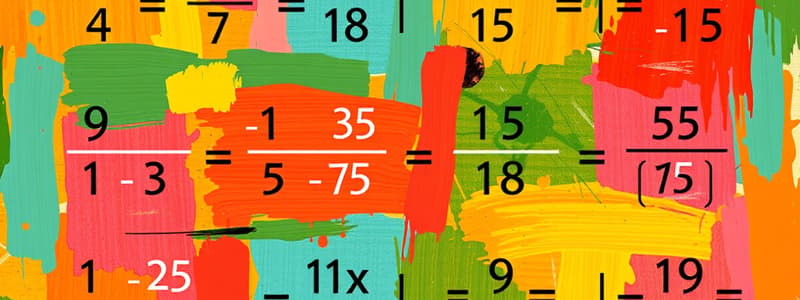Podcast
Questions and Answers
What is the simplified form of the fraction (\frac{15}{45})?
What is the simplified form of the fraction (\frac{15}{45})?
- \(\frac{1}{3}\) (correct)
- \(\frac{1}{5}\)
- \(\frac{1}{2}\)
- \(\frac{1}{4}\)
How do you convert the mixed number (3 \frac{2}{5}) to an improper fraction?
How do you convert the mixed number (3 \frac{2}{5}) to an improper fraction?
- \(\frac{15 + 2}{5}\)
- \(\frac{2 + 5}{5}\)
- \(\frac{3 imes 5 + 2}{5}\) (correct)
- \(\frac{3 + 2 imes 5}{5}\)
In a problem involving fractions, what is the first step to solve?
In a problem involving fractions, what is the first step to solve?
- Simplify the fractions.
- Identify the fractions involved. (correct)
- Set up the multiplication equation.
- Look for the common denominator.
What is the result of multiplying (\frac{2}{3}) and (\frac{4}{5})?
What is the result of multiplying (\frac{2}{3}) and (\frac{4}{5})?
When adding the fractions (\frac{1}{4}) and (\frac{1}{6}), what is the least common multiple (LCM) of the denominators?
When adding the fractions (\frac{1}{4}) and (\frac{1}{6}), what is the least common multiple (LCM) of the denominators?
Given the recipe demands (\frac{3}{8}) cup of oil but you want to make (\frac{3}{4}) of the recipe, how much oil do you need?
Given the recipe demands (\frac{3}{8}) cup of oil but you want to make (\frac{3}{4}) of the recipe, how much oil do you need?
To multiply mixed numbers, you should first convert them into what type of fraction?
To multiply mixed numbers, you should first convert them into what type of fraction?
Which step is NOT necessary when multiplying fractions?
Which step is NOT necessary when multiplying fractions?
If you have the fractions (\frac{5}{12}) and (\frac{2}{3}), what is their product?
If you have the fractions (\frac{5}{12}) and (\frac{2}{3}), what is their product?
Flashcards are hidden until you start studying
Study Notes
Multiplying Fractions
Simplifying Fractions
- Definition: Reducing a fraction to its simplest form.
- Steps:
- Find the greatest common divisor (GCD) of the numerator and denominator.
- Divide both the numerator and denominator by the GCD.
- Example:
- (\frac{8}{12}): GCD is 4, so (\frac{8 \div 4}{12 \div 4} = \frac{2}{3}).
Mixed Numbers
- Definition: A number composed of a whole number and a fraction.
- Steps to Multiply:
- Convert the mixed number to an improper fraction.
- Formula: ( \text{Whole Number} \times \text{Denominator} + \text{Numerator} ) / Denominator.
- Multiply the fractions.
- Simplify if necessary.
- Convert the mixed number to an improper fraction.
- Example:
- (2 \frac{1}{3} = \frac{2 \times 3 + 1}{3} = \frac{7}{3}).
- Multiply with (\frac{3}{5}): (\frac{7}{3} \times \frac{3}{5} = \frac{21}{15} = \frac{7}{5}) (simplified).
Word Problems
- Approach:
- Identify the fractions involved in the problem.
- Understand the context: Are you combining parts, finding a fraction of a whole, etc.?
- Set up the multiplication equation.
- Solve and simplify, if needed.
- Example:
- "If a recipe calls for (\frac{2}{3}) cup of sugar and you want to make (\frac{1}{2}) of the recipe, how much sugar do you need?"
- Calculation: (\frac{2}{3} \times \frac{1}{2} = \frac{2}{6} = \frac{1}{3}) cup.
Finding A Common Denominator
- Purpose: Necessary for adding or subtracting fractions, not directly involved in multiplication.
- Steps:
- Identify the denominators of the fractions.
- Find the least common multiple (LCM) of the denominators.
- Convert each fraction to an equivalent fraction with the common denominator.
- Example:
- For (\frac{1}{4}) and (\frac{1}{6}), the LCM of 4 and 6 is 12.
- Convert: (\frac{1}{4} = \frac{3}{12}) and (\frac{1}{6} = \frac{2}{12}).
Note
- While finding a common denominator is essential for addition/subtraction, it is not needed for multiplication—simply multiply the numerators and denominators directly.
Multiplying Fractions
Simplifying Fractions
- Simplifying fractions reduces them to their simplest form.
- Find the greatest common divisor (GCD) for the numerator and denominator.
- Divide both parts of the fraction by the GCD to simplify it.
- Example: For (\frac{8}{12}), the GCD is 4, leading to (\frac{2}{3}).
Mixed Numbers
- A mixed number combines a whole number with a fraction.
- To multiply, first convert to an improper fraction using the formula: (\text{Whole Number} \times \text{Denominator} + \text{Numerator} / \text{Denominator}).
- Example: Convert (2 \frac{1}{3}) to an improper fraction: (\frac{2 \times 3 + 1}{3} = \frac{7}{3}).
- Multiply by another fraction, e.g., (\frac{3}{5}): (\frac{7}{3} \times \frac{3}{5} = \frac{21}{15}), which simplifies to (\frac{7}{5}).
Word Problems
- Start by identifying the fractions involved in the problem.
- Understand the context of the problem (combination, fraction of a whole, etc.).
- Set up the multiplication equation based on the problem.
- Solve and simplify the result if needed.
- Example: For a recipe needing (\frac{2}{3}) cup of sugar, and making (\frac{1}{2}) of it, the calculation is: (\frac{2}{3} \times \frac{1}{2} = \frac{2}{6}), simplifying to (\frac{1}{3}) cup.
Finding A Common Denominator
- Finding a common denominator is crucial for adding or subtracting fractions, but not for multiplication.
- Identify the denominators of the fractions involved.
- Calculate the least common multiple (LCM) of the denominators.
- Convert each fraction to an equivalent fraction with the common denominator.
- Example: For (\frac{1}{4}) and (\frac{1}{6}), the LCM is 12. Convert: (\frac{1}{4} = \frac{3}{12}) and (\frac{1}{6} = \frac{2}{12}).
Note
- No need to find a common denominator for multiplication; simply multiply numerators and denominators directly.
Studying That Suits You
Use AI to generate personalized quizzes and flashcards to suit your learning preferences.




